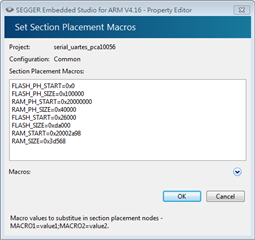

- Nrf52 sdk on segger embedded studio install#
- Nrf52 sdk on segger embedded studio drivers#
- Nrf52 sdk on segger embedded studio software#
You also need to get a couple of “SoftDevices”, Nordic’s name for the binary-only drivers they provide for some networking functionality. For Bluetooth-only development, you can use the vanilla nRF5 SDK (current version is 16.0.0). You also need to download the nRF5 SDK, which comes in a confusing array of versions.
Nrf52 sdk on segger embedded studio software#
The first time you start the Embedded Studio application, you’re offered the option of activating a free license to use the software for development with Nordic devices. The installation takes up 1.2 Gb of disk space once it’s there, and includes builds of GCC and LLVM for ARM. You can see them in /etc/udev/rules.d/les after installation.) (I think the root requirement is just because the installer sets up some udev rules for talking to J-Link debuggers. The installation program has to be run as root, which is not so good.
Nrf52 sdk on segger embedded studio install#
The install bundle for Linux comes as a single tarball containing an installation program and instructions. I’m working on Linux, and the download is about 344 Mb. IDE (SEGGER Embedded Studio)įrom the SES downloads page you can download SES for ARM–it’s available for Windows, MacOS and Linux. During installation it’s not immediately obvious that this kind of licensing applies, but it’s there on their website. SEGGER Embedded Studio (SES) is a commercial product that’s free for use with Nordic Semi devices (see the section headed “Free Commercial Use License” here). If you start at the main nRF52840 page on the Nordic Semi website, after a bit of poking around, you get to the IDEs and toolchains page where the SEGGER Embedded Studio is (sort of) recommended for use. Or rather the lack of a coherent system for doing that. The SDK code itself isn’t the problem, it’s the configuration system for including the right SDK files and setting the relevant configuration options. I don’t want to be down on Nordic about this, but the nRF5 SDK is really hard to use in a productive way. This is long, and some of it is going to sound like a rant.

Since then I've built a set of generic makefile rules for nRF SDK projects which serves as a baseline for any new projects I start.Nordic Tools Comparison: SEGGER Embedded Studio + nRF5 SDK (Back when I was working for a company that Nordic paid attention to, I complained about them and they admitted that they didn't even use them internally). You will quickly find that the example makefiles in the nRF SDK are pretty much garbage. This, coupled with the standard arm tool chain and the nRF Command Line Tools is pretty much all you need.

Once you've done that you'll be in a position to decide whether a particular embedded IDE truly suits your needs.įor my work on the nRF52* and the nRF SDK, I use VS Code with only a few generic extensions. When starting on a new platform, I find I'm much better served by learning the fundamentals of the platform directly, without a lot of "help" from tools. Embedded IDEs are often crutches, offered by companies in an effort to corral developers into their product space. This is especially true for things like editors/IDEs. My motto is always use the simplest and least platform-specific tools you can find.


 0 kommentar(er)
0 kommentar(er)
